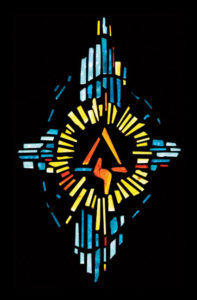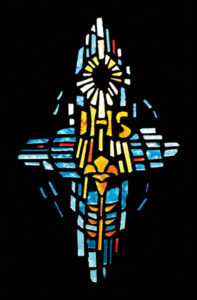With forethought and deliberateness, the windows in the chancel and nave (sanctuary) of Alpine were designed in keeping with the ancient tradition of the Christian Church to make the gospel speak through every medium available.
The overall theme of the windows is “The Life of Christ Celebrated in Worship” and “The Communion of Saints Sent out to Serve.”
As the community of believers gathers in the nave to worship they are joined by the history of the communion of saints portrayed in the side nave windows. The focus is placed on the diamond shaped windows in the north chancel wall which look down upon the altar and where the drama of worship takes place.
Worship is begun in the name of the Father, Son and Holy Spirit. God the Father, Creator, is portrayed by the window on the right base of the triangle. It features the bursting sun with the ancient Yod symbol of God in a triangle within. God, the Son, the Redeemer, is portrayed through the series of other diamond shaped windows culminating at the top of the triangle with God, the Holy Spirit, symbolized by the dove.
As worship ends, having shared in the Word and Sacrament, portrayed in the windows in each sacristy, the community of believers leave the nave passing by windows which portray the history of the communion of saints. As they pass through the Memorial Lounge they pass two windows which remind them of their mission “to rejoice in Christ” and to serve Him in the world.
THE LIFE OF CHRIST CELEBRATED IN WORSHIP
The diamond shaped windows, located above the altar, begin on the lower right and proceed to the lower left, alternating to the top.
The Life of Christ Celebrated in Worship is dedicated in memory of Hubert N. G. Ahnquist, Pastor of Alpine from 1972-1991.
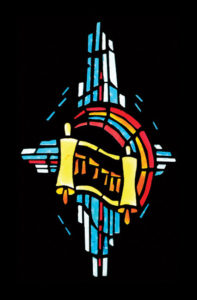 God made an initial covenant with all humanity through Noah by the sign of the rainbow (Genesis 9:13), promising never to destroy all flesh again by a flood. He also made a covenant with his people through Moses at Mt. Sinai giving them The Law portrayed by the scroll. This covenant window seeks to symbolize God’s promise of a Savior.
God made an initial covenant with all humanity through Noah by the sign of the rainbow (Genesis 9:13), promising never to destroy all flesh again by a flood. He also made a covenant with his people through Moses at Mt. Sinai giving them The Law portrayed by the scroll. This covenant window seeks to symbolize God’s promise of a Savior.
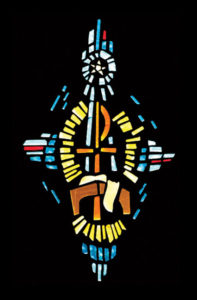 The Star of Bethlehem shines out of a radiance of blue hovering over a manger with swaddling clothes with the traditional Greek letters Chi and Rho which stand for Christ. The burst of golden sunrays suggests the birth of the divine Son of God. The form of the Chi Rho suggests also the cross for which our Lord’s life was destined.
The Star of Bethlehem shines out of a radiance of blue hovering over a manger with swaddling clothes with the traditional Greek letters Chi and Rho which stand for Christ. The burst of golden sunrays suggests the birth of the divine Son of God. The form of the Chi Rho suggests also the cross for which our Lord’s life was destined.
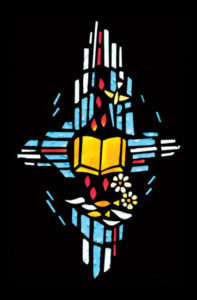 The teaching ministry of our Lord is portrayed by the parables suggested by the book, the Word of God, and the birds of the air, the flowers of the field and the fish of the sea. The descending flames of red refer to Jesus’ words in Luke 12:49, “I came to cast fire upon earth; and would that it were already kindled.”
The teaching ministry of our Lord is portrayed by the parables suggested by the book, the Word of God, and the birds of the air, the flowers of the field and the fish of the sea. The descending flames of red refer to Jesus’ words in Luke 12:49, “I came to cast fire upon earth; and would that it were already kindled.”
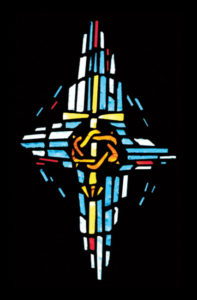 The cross is the central symbol of the story of Redemption. Here Jesus’ passion through His suffering and death is portrayed by the crow of thorns and the nails, all a part of the broken cross. “Christ died for all” (Romans 6). God so loved the world that He gave His only begotten son that whoever believes in Him should not perish but have everlasting life (John 3:16).
The cross is the central symbol of the story of Redemption. Here Jesus’ passion through His suffering and death is portrayed by the crow of thorns and the nails, all a part of the broken cross. “Christ died for all” (Romans 6). God so loved the world that He gave His only begotten son that whoever believes in Him should not perish but have everlasting life (John 3:16).
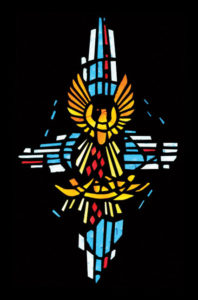 “I am the Resurrection and the Life,” Jesus says. The phoenix is a traditional symbol of the Resurrection. Out of its own ashes it rises forth. The flames are rising from the ashes together with the people portrayed by the amber wings. “If we have been united with him (Christ) in a death like his, we shall certainly be united with him in a resurrection like his” (Romans 6:5).
“I am the Resurrection and the Life,” Jesus says. The phoenix is a traditional symbol of the Resurrection. Out of its own ashes it rises forth. The flames are rising from the ashes together with the people portrayed by the amber wings. “If we have been united with him (Christ) in a death like his, we shall certainly be united with him in a resurrection like his” (Romans 6:5).
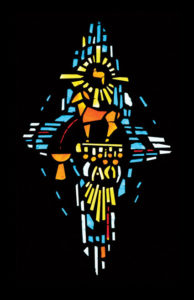 “And when he had said this, as they were looking on, he was lifted up, and a cloud took him out of their sight” (Acts 1:9). The sunburst of God (Yod) receives the Son, the Lamb of God, by whose blood we have been saved (Revelation 5:12 and Romans 5:19). The Victorious Lamb pours out His blood eternally into the chalice as a sign of the eternal covenant for those who drink of this cup (Hebrews 9:24). The Alpha and Omega proclaim Christ as the beginning and end of history.
“And when he had said this, as they were looking on, he was lifted up, and a cloud took him out of their sight” (Acts 1:9). The sunburst of God (Yod) receives the Son, the Lamb of God, by whose blood we have been saved (Revelation 5:12 and Romans 5:19). The Victorious Lamb pours out His blood eternally into the chalice as a sign of the eternal covenant for those who drink of this cup (Hebrews 9:24). The Alpha and Omega proclaim Christ as the beginning and end of history.
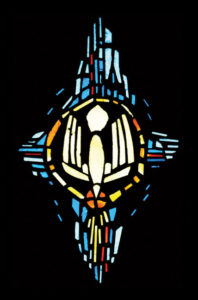 The dove within the external circle expresses the power of the Eternal Godhead. The Holy Spirit in descending posture speaks through the Word and Sacraments as the people of God gather to worship. He also sends the people of faith from the corporate worship out into the world to witness and to serve in the name of the Risen Christ.
The dove within the external circle expresses the power of the Eternal Godhead. The Holy Spirit in descending posture speaks through the Word and Sacraments as the people of God gather to worship. He also sends the people of faith from the corporate worship out into the world to witness and to serve in the name of the Risen Christ.
THE COMMUNION OF SAINTS SENT OUT TO SERVE
The order begins at the front left proceeding then to the front right, alternating back from left to right.
The Communion of Saints Sent Out to Serve is dedicated in memory of Hubert N. G. Ahnquist, Pastor of Alpine from 1972-1991.
The Nave Windows
In John 3:5 Jesus says, “Truly, I say to you, unless one is born of water and the spirit, he cannot enter into the kingdom of heaven.” This proclamation is carried out symbolically in the Communion of Saints nave windows by the flowing blue – aqua colors designating water, and the flames of red designating the spirit. The community of believers is established through the water and spirit in baptism and sustained by that same Holy Spirit.
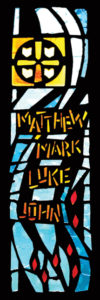 The Evangelists
The Evangelists
The four Evangelists, Matthew, Mark, Luke and John tell the Good News of Jesus Christ. Through them the new Covenant is made known and the Church of Jesus Christ begins. They represent the first century Communion of Saints. The word evangelist comes from the Greek word evangel, which means “The Good News.”
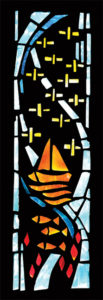 The Apostles
The Apostles
The disciples, whom Jesus called and of whom the Evangelists wrote, become Apostles, those who were sent by the Ascending Christ to “go and make disciples of all nations.” The twelve golden crosses stand for the twelve apostles who were called to be fishers of men. The fish express this commission. The ship is the traditional symbol of the church. These apostles established the church in the world. The word Nave means ship, defining the place where the people of God gather for worship.
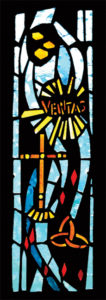 The Church Fathers
The Church Fathers
As the church grew in the early centuries, attempts were made to make concise summary statements of its basic faith. These were called Creeds, stating what the Communion of Saints believed about God the Father, Son and Holy Spirit. The earliest such Creed was the Apostles’ Creed. By the fourth century the Nicene Creed was adopted. These creedal statements on the Trinity are expressed by the trefoil symbol at the bottom of this window. Three representative Church Fathers are portrayed in descending order. The three stones stand for St. Stephen, the first martyr of the church. Veritas, meaning truth, stands for St. Augustine of the 4th century. The stone embedded cross represents St. Francis of Assisi of the 12th century. These only represent many whose lives contribute to the formation and witness of the creedal faith.
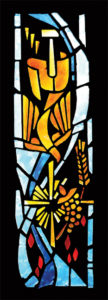 The Reformers
The Reformers
The need for church reform is always present as the church lives in the world. Historically, the greatest reformation period is identified with Martin Luther in the 16th century. He ignited the flame with the nailing of the 95 Theses on the church door at Wittenburg, Germany. The nails, hammer and theses are portrayed here as a symbol for reform. The amber dove of the Holy Spirit descends giving guidance and protection to the preservation of Word and Sacraments portrayed by the cross and the grapes and wheat. The water and the Spirit prevail here too.
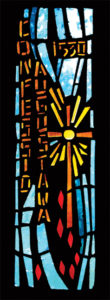 Confessio Augustana
Confessio Augustana
The name of this window is the official Latin word for the Augsburg Confession, which was presented by Luther and Melanchthon in 1530 in an attempt to clarify the faith statements of the reformers and to help reconcile the divided church. The cross radiates the faith that continues to be proclaimed through the followers of the Reformation, especially those who became known as Lutherans. The word Augustana was adopted by the Swedish Lutherans as they established a Lutheran witness here in America. Historically the Alpine church came from this heritage line.
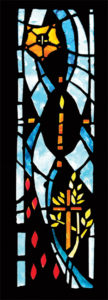 The Lutherans in America
The Lutherans in America
The Lutheran expression of the Communion of Saints included many ethnic groups from Europe. During the 20th century many of these groups merged together for a joint witness of faith when language barriers were no more. Luther’s seal of the rose and cross declares this common Lutheran witness. The candle formed by the amber blocks from the four sections of America, north, south, east, and west, express these mergers. The cross amid the living branch declares the faithful proclamation of the Gospel through the united fellowship of believers.
The Memorial Lounge
As we leave the worship service we pass through the Memorial Lounge where two windows declare our mission.
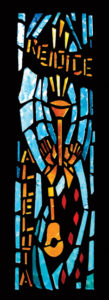 Celebration
Celebration
On the west are the words “Rejoice” and “Alleluia.” The raised hands express that manner of praise as we go out in the name of our victorious Risen Lord, Alleluia. The trumpet and the guitar suggest the music of joy filled praise. The Christian life is a life that declares the hope and the joy that the message of Christ offers in the face of all circumstances.
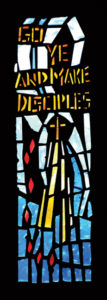 Mission
Mission
On the east is the reminder to all who worship that our worship has only begun. It continues as we go out into the world with the message of the cross, making disciples among all people (Matthew 28:11). The golden rays protruding from the cross are extending into the darkness of the world, bringing light and hope.
The Sacristy
The windows in each of the sacristies behind the altar portray the marks of the church, the Word and the Sacraments. It is by the Word (The Scriptures), and the Sacrament of Baptism and the Lord’s Supper that the Communion of Saints is established and sustained.
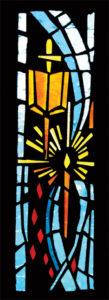 The Word
The Word
The living word is Christ Jesus who is brought to us through the written record of God’s mighty acts in history, the Holy Scriptures. This Word is depicted by the open book and the sword. The Word is like a two edged sword (Hebrews 4:12). That Word sheds light upon the pathway expressed by the radiating candle.
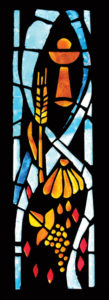 The Sacraments
The Sacraments
Through Baptism we are made children of God and given the promise of life and salvation. This initiating Sacrament is portrayed by the shell and the three drops of water – Father, Son and Holy Spirit. Through the Holy Eucharist the life of the believer and the church is renewed. The chalice and host, together with the wheat and the grapes, depict this sustaining Sacrament. Again the water and the spirit theme is carried out in these windows.

